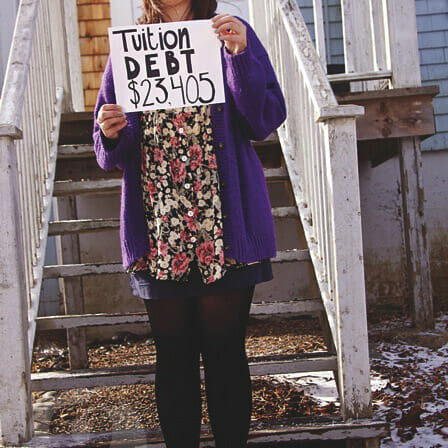

In Nova Scotia, 2,200 students are $3,000 short of having enough | to pay for tuition, rent, books and food. Photo by Adele Van Wyk
In the wake of the provincial government’s announcement to allow tuition to increase by three per cent, student groups are developing new ways to talk to the government about supporting students—without spending money.
Mark Coffin, executive director of the Alliance of Nova Scotia Student Associations (ANSSA), says the group has put together three proposals that he hopes will strike a chord with the premier. He also hopes to reconnect politicians and students through a new social media campaign on their website, studentsspeakout.ca, where the students in most need of assistance can make their voices heard.
The goal of ANSSA’s three proposals will be to help the students who are struggling the most to pay their way through post-secondary education.
In Nova Scotia, there are 2,200 students who are $3,000 short of having enough money to pay for tuition, rent, books and food.
“What we’ve been saying is that education is an investment. And if your number one expense right now is health care, you can’t cut education and not think about the fact that people who go through post-secondary education end up being the people who use the health care system the least and put the most into the tax system,” says Coffin. “So that’s a pretty good investment from any investor’s point of view.”
The first proposal, to remove the cap on student assistance, appears to cost about $6.9 million. But Coffin says the government owes students the rest of the $14 million they said they would spend on a graduate retention rebate program during elections in 2009.
Coffin says it would be more beneficial to students if the government reallocated the roughly $10 million left to spend toward student aid.
“If you are intending to retain graduates, you need to create graduates. If you want to create graduates, you need to have accessible schools,” says Coffin. “The reality is that they made a commitment to spend that money on students, on young people and on graduates.”
The second proposal is to make tuition tax credits refundable. As it stands, a full-time student can claim about $7,000 off their taxable income but only if they earn enough to have taxable income.
Coffin suggests expanding the program so that instead of students deferring their credit into the future—when it will become an expense to government—they can pay it out now.
“This way you can save yourself money in the future, but all in all, it’s the same amount spent,” he says.
This simple adjustment would give approximately $600 to the students who need it most, “which is enough to cover a few months worth of groceries or a university course,” says Coffin.
The final proposal is to make Nova Scotia the first province in the country to eliminate provincial student loans for a first degree.
“It would save money if they did that because right now they are essentially doing it through the debt cap program they introduced last year,” says Coffin. By making this change, the government would be able to save 30 cents to the dollar of every loan on which they have to pay interest and servicing costs over the course of the degree.
Up front programming and up front assistance have been more effective than back end debt caps with back end tax credits, says Coffin. The proposal will be presented to the finance minister in March.
It’s a seemingly obvious fix to a series of complicated problems, which raises the question: why has no one thought of it before?
“I don’t think the right people, the people making the decisions, are talking to one another,” says Coffin. So to connect the two worlds, Coffin and his team will be creating a video-style social media campaign on studentsspeakout.ca.
“We talk about these numbers a lot, but then we sort of lose the connection with the person behind these statistics,” says Coffin.
ANSSA will be collecting videos that students upload to YouTube, and will then post them to their site. Later, they will send the videos to the premier himself.
“We were having a lot of meetings with people in government where it just felt like people didn’t understand where these students where coming from,” says Coffin. So what better way to make students’ voices heard?
As Coffin says, “Just sit down in front of your computer and press record.”






